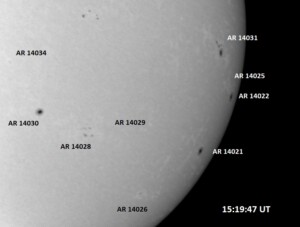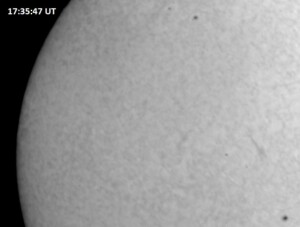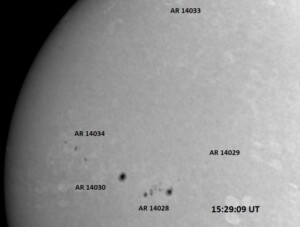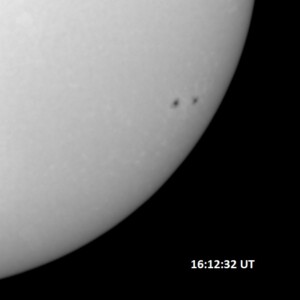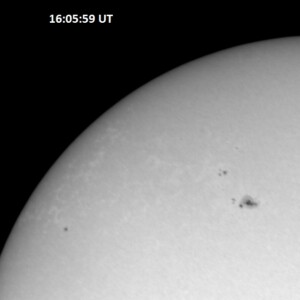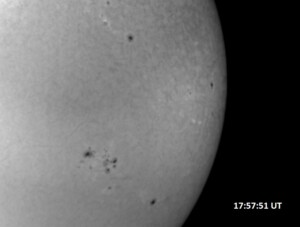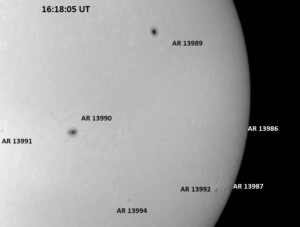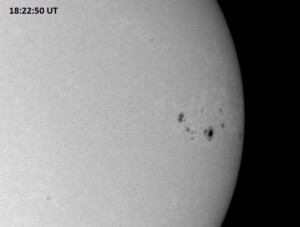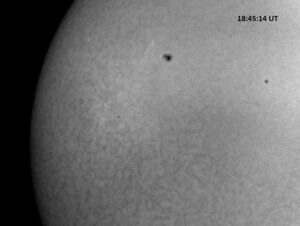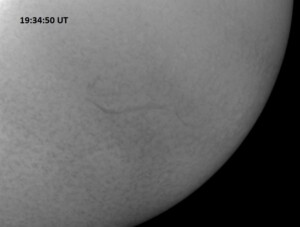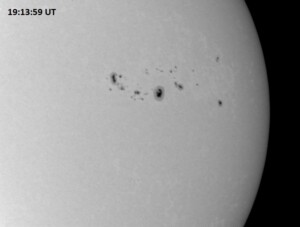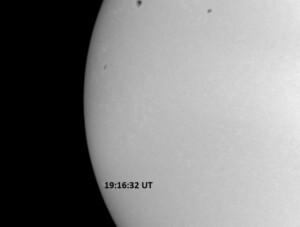The Latest Solar Images
Note: All images on this website © 2018-2025 by Brian Cudnik and Prairie View A&M Physics. All rights reserved.
Observations are happening daily, except for most Saturdays, all Sundays, and holiday periods; and are governed by duty schedule, weather, and solar activity. When the Sun has very low activity (spotless), observations will be limited or non-existent. Whenever the Sun becomes active again, the observing program will become active as well, weather permitting. The Sun is expected to reach the maximum activity level of the current Cycle 25 solar cycle. So we anticipate more events in terms of active region size and number, and solar flares.
One can monitor the Sun via several websites that provide real-time images of the Sun. The website, https://www.solarmonitor.org/, has such images in six different channels. The numbers are the NOAA designations for active regions (with the “1” at the start of the designation removed for convenience). Another website with up-t0-date information on solar activity and other goings-on in the skies is www.spaceweather.com. Additional information about the Sun’s current activity can be obtained from https://www.swpc.noaa.gov/, and real-time full-disk H-alpha images from observatories around the world can be viewed at http://halpha.nso.edu/.
A typical observing run may last from one to four hours, depending on seeing considerations, weather, and other work responsibilities, but will include active region monitoring of available active regions and the collection of frames for high-resolution solar mosaics in H-alpha. Each session includes at least one mosaic, which is a series of images made of all parts of the Sun’s disk that can later be stitched together to form a whole-disk image. At the very least, this ensures that all visible features such as prominences, filaments, and active regions (sunspot groups) are all captured in image form at least once per session. Usually observations are carried out in the late morning hours, but an additional session may occur in the mid-afternoon hours and it will include its own mosaic. If a sunspot group is expected to be active, then it becomes a main focus for observation for extended periods of time.
Solar activity is summarized in each day’s entry below, based on the forecast discussion product issued by the Space Weather Prediction Center each morning, along with observed activity (or lack of) the day of the featured observations. Regions are numbered by the NOAA/SWPC and are often provided in four-digit format (e.g. 3327), although I and other sources use the full five-digit designation (13327). Solar flares are described in terms of their X-ray intensity and optical “importance” (apparent brightness and area covered). One can learn more about the X-ray class of solar flares often discussed below by going to this website: https://www.spaceweather.com/glossary/flareclasses.html. Finally the SWPC 3-day forecast for solar activity is provided at the end of each entry.
More information about solar flares can be found at these websites: https://www.swpc.noaa.gov/phenomena; https://www.space.com/solar-flares-effects-classification-formation; and https://www.spaceweatherlive.com/en/solar-activity/solar-flares.html. I have also found the following website to be very useful: spaceweatherlive.com
The solar images are recorded through a Meade 16-inch f/8 Cassegrain telescope equipped with a 0.3 Å Hydrogen-alpha filter and a 16-bit, 3326×2504 pixel SBIG STF-8300 CCD camera. The aperture of the scope is stopped to 4-7/8 inch by an energy-rejection filter, which renders the system an f/26. A neutral density filter is added to bring the sunlight intensity down by 90%. Each image is automatically dark-subtracted as it is saved and each exposure is 0.1 second long for the red off-band continuum images and 0.5 second for the on-band H-alpha images. Flat field images are taken at periodic intervals throughout the observing session and are obtained by training the telescope to focus near the center of the Sun’s disk. Five images are then taken while dithering the frame 1′ to 5′ N,S,E, and W. The idea is to try to get images that are slightly blurred (either due to seeing or scope motion) and off set from each other. A set of 30 bias images (0-second exposures with the dome closed and scope parked) are taken at the end of each observing session.
Select images are processed for further study and display. A program called MaxIM DL is used to do basic calibration (bias-subtraction and flat field correction), and the levels are adjusted for optimum display contrast. Choice images are then selected for online display. All of the images are archived in their raw FITS format, sorted by date, and backed up twice. At a later time we can mass process these and make them available for scientific use. Inquiries can be made of Brian Cudnik, at bmcudnik@pvamu.edu, or Premkumar Saganti, at pbsaganti@pvamu.edu.]
NOTE: Images of the March 14 total lunar eclipse are posted at https://www.pvamu.edu/pvso/cosmic-corner/total-lunar-eclipse-1/
NOTE: Images of the April 8 solar eclipse are posted at https://www.pvamu.edu/pvso/cosmic-corner/partial-solar-eclipse/.
Observations have been conducted since then at the PVSO, primarily with H-alpha. There was a period of time when magnetospheric data were collected but the work had primarily been regional H-alpha images of active regions and filaments. Regular observations continued through the mid-2000’s, then became more sporadic through 2015. After a five-year pause, regular observations resumed (in their current format) on 8 January 2020.
March 31,2025
Solar activity reached high levels yesterday due to the high number of M-class flares. Between 21:00 UT on 29 March and 10:30 UT on 31 March, there were 9 M-class flares. The largest of these was an M1.6 flare at 16:42UT on 30 March. This region was the source of an X1.1 flare that occurred at 15:19 UT on 28 March (when we usually observe, but it was cloudy), the first such flare in over a month. The last X-class flare was an X2 from AR 14001 at 19:27 UT on 23 February. There have been a total of five X-class solar flares in 2025 so far. The largest solar flare of Solar Cycle 25 was an X9 on 3 January 2024.
The CME from the most recent X-flare event narrowly missed Earth. Had it impacted, it would have produced a major storm, comparable to those experienced 11 May 2024 and 11 October 2024. In the meantime, AR 14048 is growing, as is AR 14043, but the latter remained relatively quiet. AR 14044, 14046, and 14047 all showed growth. So fare AR 14048 produced the vast majority of the frequent C-class flares today, along with a single M1.2 at 10:24 UT. AR 14046 contributed a handful of events today. Apart from these two, the rest of the active regions were unremarkable.
Each of the below images spans 13.8’x18.0′ on the sky. The first column contains red continuum images, each 0.5 second exposures. The second column contain H-alpha images, each 0.5 second exposures. Celestial north is up, west is right in each image.
M-class flares are likely, with a 60% chance overall. There is a slight chance, 15%, for X-class flares through 2 April primarily due to the activity of AR 14048.
March 25,2025
Solar activity continues to be at low levels, with only C-class flares occurring. There was almost an M-class flare this morning: a C9.5 peaking at 12:29 UT from an undisclosed region (GONG imagery seems to indicate AR 14028 as the possible source). This was the largest flare since the M1 we observed on 21 March. After this, the largest flare was a C5.2 from AR 14035 at 7:37 UT on 24 March. This region has been decaying. AR 14036, however, has been growing and was the source of most of the flares yesterday and (at least early) today. The region appeared notably larger and more complex during this morning’s visual sunspot count observations, and there are indications the magnetic complexity is increasing as well. However, this region is about to rotate over the western limb so it will be out of our view in three days.
There are a total of seven spotted regions (6 numbered, one un-numbered) and six numbered spotless regions on the visible disk of the Sun. Aside from ARs 14036, 14030 (on the west limb) and a new spot grouping on the east northeast limb, the whole of the solar disk is almost completely spotless.
Each of the below images spans 13.8’x18.0′ on the sky. The first column contains red continuum images, each 0.25 second exposures. The second column contain H-alpha images, each 0.5 second exposures. Celestial north is up, west is right in each image.
There is a 30% chance for an isolated M-class flare and a 5% chance for an X-class flare (would most likely come from departing region 14036) through 27 March.
March 24,2025
Solar activity remains at low level. AR 14028 produced a C4.5 flare at 14:22 UT, yesterday, 23 March as it slowly decays. AR 14035, despite its very weak appearance, produced a C5.2 flare today at 7:37 UT. AR 14026 produced a C2.3/SF at 13:36 UT today. Otherwise these, and all the spotted active regions on the visible solar disk, remained quiet. A C1.8 flare occurred at 20:49 UT (the biggest since the C2.3 event earlier), and may have come from 14:36, but no event reports after 14:00 have been posted.
Each of the below images spans 13.8’x13.8′ on the sky. The first image is a red continuum image, 0.25 second exposure. The second is an H-alpha images, 0.5 second exposure. Celestial north is up, west is right in each image.
C-class flares are expected to continue, along with a chance for isolated M-class flares, through 26 March.
March 22,2025
After Friday’s M1.2/1N flare from AR 14028 at 15:34UT, 21 March, solar activity returned to low levels. The flare produced a fast, faint partial halo CME which is expected to impact the Earth’s magnetic field early on 23 March. AR 14033 returned as a group of tiny spots; AR 14036 is growing rapidly, gaining additional spots and magnetic complexity. New spots in the eastern half of the solar disk were small and quiet. AR 14035 is in a state of decay.
AR 14035 produced a C5.0/SF at 17:17 UT today, and AR 14036 produced a trio of subflares from 14:01 to 14:49 UT; all else was quiet all day.
Each of the below images spans 13.8’x18.0′ on the sky. The first column contains red continuum images, each 0.25 second exposures. The second column contain H-alpha images, each 0.5 second exposures. Celestial north is up, west is right in each image.
C-class flares are expected to continue, along with a chance for isolated M-class flares, through 24 March.
March 21,2025
Solar activity reached moderate levels today. AR 14028 produced an M1.2 flare at 15:58 UT today, the largest of the period and the largest since the M1.0 earlier this week. Prior to that AR 14025 produced a C4.4 flare at 17:10 UT on 20 March. We observed a significant part of each event at the Solar Observatory. AR 14031 is developing additional spots in its trailing half. Several new (and tiny) spot groups were noted on the Sun: two emerged near the central meridian north of the solar equator and are growing rapidly, and two rotated into view along the eastern limb. The remaining numbered active regions remain quiet and small.
A filament erupted near the eastern limb at 18:13 UT yesterday (after our observing session ended) but no CME was observed from this event. A fairly large prominence was seen on the eastern limb, which appeared to be lifting off (one footpoint remains on the surface, the other end is aloft). As of this writing, (21:00 UT) it appears to be thinning and disappearing. This prominence and the M1.2 flare one minute after its X-ray peak, are shown immediately below. Each is a 0.25 second exposure in H-alpha.
Each of the below images spans 13.8’x18.0′ on the sky. The first column contains red continuum images, each 0.25 second exposures. The second column contain H-alpha images, each 0.5 second exposures. Celestial north is up, west is right in each image.
C-class flares are expected to continue, along with a chance for isolated M-class flares, through 23 March.
March 21,2025
Solar activity reached moderate levels today. AR 14028 produced an M1.2 flare at 15:58 UT today, the largest of the period and the largest since the M1.0 earlier this week. Prior to that AR 14025 produced a C4.4 flare at 17:10 UT on 20 March. We observed a significant part of each event at the Solar Observatory. AR 14031 is developing additional spots in its trailing half. Several new (and tiny) spot groups were noted on the Sun: two emerged near the central meridian north of the solar equator and are growing rapidly, and two rotated into view along the eastern limb. The remaining numbered active regions remain quiet and small.
A filament erupted near the eastern limb at 18:13 UT yesterday (after our observing session ended) but no CME was observed from this event. A fairly large prominence was seen on the eastern limb, which appeared to be lifting off (one footpoint remains on the surface, the other end is aloft). As of this writing, (21:00 UT) it appears to be thinning and disappearing. This prominence and the M1.2 flare one minute after its X-ray peak, are shown immediately below. Each is a 0.25 second exposure in H-alpha.
Each of the below images spans 13.8’x18.0′ on the sky. The first column contains red continuum images, each 0.25 second exposures. The second column contain H-alpha images, each 0.5 second exposures. Celestial north is up, west is right in each image.
C-class flares are expected to continue, along with a chance for isolated M-class flares, through 23 March.
March 20,2025
Solar activity returned to low levels after yesterday’s M1.5 flare. Today, there has only been three C-flares so far: a C5.6 from AR 14031, a C2.5 from AR 14022, and a C4.4 from AR 14025. We observed this flare from four minutes after its peak until the end of the X-ray event. ARs 14028, 14034, and 14035 have grown slightly while ARs 14020, 14022, 14025, and 14031 all appear to be decaying. Currently there are 11 numbered active regions and 2 un-numbered active regions on the visible disk today, but everything has remained mainly quiet (through 19:39 UT, 20 March).
Each of the below images spans 13.8’x18.0′ on the sky. The first column contains red continuum images, each 0.25 second exposures. The second column contain H-alpha images, each 0.5 second exposures. Celestial north is up, west is right in each image.
C-class flares are expected to occur, along with a chance for isolated M-class flares, through 22 March.
March 19,2025
Solar activity reached moderate levels with an M1.5 flare from AR 14031 at 20:40 UT today. Prior to this, only minor C-class flares happened yesterday and today, rendering the activity level low. There are 11 spotted active regions on the visible disk today (down from 13 yesterday) and several of these have grown slightly. AR 14025 is growing overall but had not produced any flares so far today. In addition to the M1.5 flare, AR’s 14028, 14030, and 14031 have each produced one C2 event so far today (through 21:05 UT). All the other regions are unremarkable.
Each of the below images spans 13.8’x18.0′ on the sky. The first column contains red continuum images, each 0.50 second exposures. The second column contain H-alpha images, each 0.5 second exposures. Celestial north is up, west is right in each image.
More C-class flares are expected to occur, along with a chance for isolated M-class flares, through 21 March.
March 18,2025
After briefly reaching moderate levels with the C9.8/M1.0 double flare from AR 14033, solar activity has returned to low levels. Frequent C-class flaring occurred before and since this event, but mostly ended with a C3.0 from AR 14028 at 4:26 UT this morning. Since then, nothing significant has occurred or been reported, through 23:00 UT (the flat X-ray plot was punctuated by a C2.1 at 21:12 UT today but no information is yet available about the source). The double-flare produced two Coronal Mass Ejections which may weakly impact the Earth’s magnetic field on 19 March. There are a total of 13 spotted active regions visible on the solar disk, but all of them are rather unremarkable. However, AR’s 14025, 14028, and 14031 each have what is called a beta-gamma magnetic type, meaning conditions are somewhat favorable for each of these to produce C- and M-class flares.
Each of the below images spans 13.8’x18.0′ on the sky. The first column contains red continuum images, each 0.50 second exposures. The second column contain H-alpha images, each 1.0 second exposures. The H-alpha images were made through a thin veil of cirrus, reducing the H-alpha contrast. The cirrus lingered for much of the morning, then cumulus clouds appeared by mid-day. The winds kicked up and atmospheric seeing was expected to deteriorate after 17:00 UT. Celestial north is up, west is right in each image.
The three active regions with the “beta-gamma” magnetic configurations mentioned above combine to provide a chance for isolated M-class flares and a slight chance for an X-class flare through 20 March.
March 17,2025
Although solar activity had been reported to be at low levels (prior to this afternoon’s M1.0 flare), this morning’s NOAA-SWPC discussion contains a lot of action. AR 14028 is growing and is one of the largest of the 13 visible spotted active regions on the Sun. It produced a C6.5/SF at 22:32 UT, 16 March, and a C7.8/1F flare at 5:42UT today. It produced a C2.7/SF at 14:30 UT today, then has been mostly quiet. ARs 14025 and 14031 continue to grow but were mostly quiet. ARs 14021 and 14034 also showed some slight growth but were otherwise quiet. Everything else was quiet and stable. A double peaked C-class event (C6.6 at 16:04 UT, and a C5.3 at 16:18 UT) was observed during today’s session. Later in the day, AR 14033 produced a C9 flare at 19:19 UT, which was immediately followed by a long-duration M1.0 event from the same active region, which peaked at 19:33 UT. These events were not observed at PVSO.
There was a disappearing solar filament yesterday which produced a CME, heading north away from the solar disk. A pair of eruptions occurred yesterday from AR 14032. These produced a pair of CMEs, which could offer a glancing blow late on 19 March but details are still pending. At around 10:32 UT today, an approximately 5 degree long filament erupted from the northwest quadrant of the solar disk. It is not yet clear whether this produced a CME. AR 14032 decayed to spotless plage yesterday.
Each of the below images spans 13.8’x18.0′ on the sky. The first column contains red continuum images, each 1.00 second exposures. The second column contain H-alpha images, each 0.5 second exposures. Celestial north is up, west is right in each image.
Solar activity is expected to be low, with a chance for M-class flares and a slight chance for X-class flares through 19 March.
March 12,2025
Solar activity is slowly increasing with more frequent C-class flares, which include two near-M-class events. No region is (yet) attributed to the C-class flares reported today, although most of these have come from AR’s 14024, 14027, and an unnumbered region that is just starting to rotate into view on the ESE limb. AR 14012 is quiet and continues to slowly decay as it starts to rotate out of view; AR 14024 is also decaying as it rotates out of view. ARs 14019 and 14020 are slowly growing, as are AR’s 14025, 14026, and 14027, each of which emerged on the disk in the last day or two.
Each of the images below is a 0.5 second exposure and spans 13.8’x18.0′ on the sky (unless otherwise indicated). Celestial north is up, west is right in each image.
There is an increasing chance for M-class flares through 14 March.
March 11,2025
Solar activity remains low with only low-level C-class flare activity occurring. There was a bit of an uptick in activity today as newly emerged AR 14024 (due north of 14012) began to flare. It produced an M1.1 at 13:04 UT today, then a C5.8 at 18:30 UT. There was a C7.2 event at 19:16 UT today and a C9.6 at 21:22 UT today but no information is yet available as to the source(s) of these events. AR 14012 continues to decay as it approaches the western limb and it remained quiet yesterday and all day today. AR 14019 is growing and may have increased potential for M-class flare activity in the coming days. There are a total of 8 spotted regions visible on the Sun today: two small ones are about to rotate out of view, and the remaining occupy the northeast quarter of the solar disk.
Each of the top row of images spans 13.8’x13.8′ on the sky; each of the bottom row images cover 13.8’x18.0′. The first column contains red continuum images, each 0.25 second exposures. The second column contain H-alpha images, each 0.5 second exposures. Celestial north is up, west is right in each image.
There is a chance for M-class flares through 13 March as AR 14019 grows in size and complexity.
March 10,2025
Solar activity continues to be at low levels. Only minimal C-class activity occurred yesterday and today. A lone M1.6 flare occurred on 7 March at 21:00 UT, but everything has been quiet since. The largest event since yesterday’s C2.5 at 18:54 (from an unnumbered region that is just rotating into view) was a long-duration C2.0 flare that appears to have come from AR 14020 (based on GONG imagery). This event peaked at 20:32 UT today. AR 14012 continues to decay and produced a few minor C-class flares yesterday, nothing today. AR 14019 is beginning to grow but was quiet all day today. It did produce a C1.7 flare yesterday at17:21UT. AR 14018 is also showing signs of growth, but has been quiet. All the other numbered regions were unremarkable.
Each of the images below span 13.8’x13.8′ on the sky. The first column contains red continuum images, each 0.25 second exposures. The second column contain H-alpha images, each 0.5 second exposures. Celestial north is up, west is right in each image.
There is a chance for M-class flares through 12 March as AR 14019 grows in size and complexity.
March 6,2025
Solar activity remained low today with only occasional low-level C-class flaring. AR’s 14007 and 14012 have decayed some, AR 14016 has grown earlier but is now mostly stable, and the rest of the spotted active regions are either stable or in decay.
Each of the top row of images spans 13.8’x13.8′ on the sky; each of the bottom row images cover 13.8’x18.0′. The first column contains red continuum images, each 0.25 second exposures. The second column contain H-alpha images, each 0.5 second exposures. Celestial north is up, west is right in each image.
There is a chance for M-class flares and a slight chance for X-class flares from 6 to 8 March due to ARs 14012 and 14016.
March 5,2025
Solar activity bumped up to moderate levels with an impulsive M1.7 flare at 11:50 UT today (5 March). This was the first M-class flare from any region in over one week. Since the event, the Sun returned to low activity levels with only a C1 flare from AR 14007 at 17:38 UT. AR 14016 produced a C1 flare at 0:44 UT today, and AR’s 14009 and 14012 each produced a C1, at 2:54 UT and 8:26 UT, respectively. ARs 14012 and 14016 continue to grow. The remaining spotted active regions appear to be in decay.
Each of the below images spans 13.8’x13.8′ on the sky. The first column contains red continuum images, each 0.25 second exposures. The second column contain H-alpha images, each 0.5 second exposures. Celestial north is up, west is right in each image.
There is a 40% chance for M-class flares and a 5% chance for X-class flares from 5 to 7 March as AR 14012 has grown.
March 4,2025
Solar activity continues to be low and has been so since last week. The largest flare (yesterday or today) was a C4.6 event at 15:45 UT from AR 14012. This region, along with AR 14006, has been responsible for all of the flares, all low-level C-class. AR 14006 is in decay as it rotates out of view, but AR 14012 is growing in size and spot number. AR 14007 also showed some growth but remained quiet.
Each of the below images spans 13.8’x13.8′ on the sky. The first column contains red continuum images, each 0.25 second exposures. The second column contain H-alpha images, each 0.5 second exposures. Celestial north is up, west is right in each image.
Solar activity is expected to remain low, with a chance for M-class events through 6 March. If AR 14007 and/or 14012 continue to grow in size and complexity, the M-class events could become more likely, and a slight chance of X-class events could be possible.
February 28,2025
With clear skies once again, follow up observations of a quiet Sun were made in the late morning hours. Solar activity continues to be at low levels with only C-class activity (C5 and less since 0:00 UT, 28 February through at least 23:11 UT) occurring fairly regularly. AR’s 14009 and 14010 emerged onto the solar disk (see labeled image below), and they weren’t visible (through the thin clouds) yesterday. All of the regions were stable or in decay. AR’s 13998, 14006, and 14007 were the sources of the flares.
Each of the below images is a 0.5 second exposure and covers 13.8’x18.0′ of sky. The first two are identical red continuum images, the second of which is labeled. The third (right most) image is H-alpha line center. Celestial north is up, west is right in each image.
M-class events continue to be forecasted to be likely today (28 Feb.) and tomorrow (29 Feb.), with a chance of X-class flares during this period. There is a chance for M-class flares on 2 March, with X-class flaring unlikely by then.
February 27,2025
Weather was cloudy today but the clouds thinned enough to allow the Sun to shine through fairly strongly. This was enough for a complete set of continuum images, although they were made through cirrostratus clouds of varying thickness. H-alpha imaging was attempted, unsuccessfully, due to even the presence of thin clouds greatly reducing the contrast.
Solar activity remained at low levels. AR 14007 produced a C5.7 flare at 12:42 UT on 26 February. AR 13998 produced a C5.7 event at 6:34 UT on 27 February. This region decayed some as it exited the solar disk, being carried away by the Sun’s rotation. Shortly after this flare, AR 13998 produced a C7.5 event at 12:36 UT, then was quiet for the rest of the day. AR 13996, also rotating out of view, produced a near-M-class event: a C9.3 flare at 23:24 UT, the largest in over two days.
A filament erupted in the southwest part of the solar disk on 26 February and produced a CME that became visible to SOHO by 14:48 UT. This CME is expected to miss the Earth, passing by ahead of the Earth in it’s orbit.
Each of the below red continuum images is a 0.5 second exposure and covers 13.8’x18.0′ of sky. Celestial north is up, west is right in each image.
M-class flare events continue to be likely, with a chance for X-class events, from 27 February t0 1 March.
February 26,2025
Solar activity returned to low levels. The last M-class flare (to date, as of 20:45 UT) was the long-duration M3.6/1F flare at 11:59 UT yesterday from AR 13998. Since then, only occasional low-level C-class flares have occurred. AR 14007 produced a pair of C-class flares: a C3.6 at 3:45 UT today, and a C5.7 at 12:42 UT today. After these, AR 13998 produced a pair of C-class flares: a C2.9 at 14:29 UT today and a C4.4 at 18:50 UT today. The remaining regions were quiet today and most of yesterday.
Each of the below images spans 13.8’x13.8′ on the sky. The first column contains red continuum images, each 0.25 second exposures. The second column contain H-alpha images, each 0.5 second exposures. Celestial north is up, west is right in each image.
M-class flares are likely with a chance for X-class flares from 26 to 28 February.
February 25,2025
Solar activity remains at moderate levels. ARs 14000 and 14001 produced M-class flares yesterday, and AR 13998 only produced C-class flares yesterday. Today, it was the source of an M1.3 flare at 2:47 UT and an M3.6/1F flare at 11:59 UT. The Sun has been mainly quiet since, punctuated by a C4.2 from 13998 at 17:58 UT; and a C4.1 at 18:10 UT from AR 14000 (just as the clouds began to break up at the PV observatory. Except for the two C-class events, the X-ray curve has been quite flat (gently sloping down) since 112:45 UT, through at least 21:10 UT.
The long duration M3.9 flare from yesterday actually came from a region off the southwest limb at solar latitude S14. The flare peaked at 23:02 UT, and a CME emerged from this location a few hours later. The cloud of charged particles is expected to pass ahead of Earth in its orbit, missing it totally.
Each of the below images spans 13.8’x13.8′ on the sky. The first column contains red continuum images, each 0.25 second exposures. The second column contain H-alpha images, each 0.5 second exposures. Celestial north is up, west is right in each image.
M-class flares are likely with a chance for X-class flares from 25 to 27 February.
February 24,2025
Since 20 February, solar activity increased to high levels. From 21 February to this writing (23:15 UT, 24 February), nine M-class flares and one X-class flare occurred. The X class flare was an X2.0 from just over the Sun’s western limb from departing AR 14001. It also produced an M1.3 flare today (24 February) at 1:46 UT. This region since became quiet as it rotated out of view, but may be responsible for the current longer-duration M-class flare (peaking at M3.9 at 23:06 and has slowly started to decrease). The GONG H-alpha images have not shown any signs of flare activity during this event. AR 14000 produced an M1.3 flare at 7:02 UT, and an M1.5 at 21:01 UT today. AR 13398 was the source of four C-class events, the largest of which was a C8.7 at 13:20 UT today.
Each of the below images spans 18.0’x13.8′ on the sky. The first column contains red continuum images, each 0.25 second exposures. The second column contain H-alpha images, each 0.5 second exposures. Celestial north is up, west is right in each image.
M-class flares are likely with a chance for X-class flares from 24 to 26 February.
February 20,2025
Solar activity continues to be at low levels, with no M-class flares since the M1.0 event at 15:15 UT on 17 February. Since then, only C-class activity was observed. The largest event since then (up to the time of this writing, 21:20 UT) was a C8.1 at 23:45 UT on 19 February, which came from near plage associated with spotless region 13991. This produced a Coronal Mass Ejection off the SW part of the solar disk. AR 13996 is the largest and most complex active region on the visible disk, but only produced some C-class flares. AR 13998 is showing some magnetic flux emergence but has been quiet, producing only a C1.3 flare at 14:08 UT on 19 February. AR 13996 had been responsible for most of the flares observed today. It produced 4 low-level C-class flares (3- c1 and 1 C4) between 0:00 and 23:15 UT today.
Each of the below images spans 18.0’x13.8′ on the sky. The first column contains red continuum images, each 0.25 second exposures. The second column contain H-alpha images, each 0.5 second exposures. Celestial north is up, west is right in each image.
Solar activity is expected to be low with a chance for isolated M-class flares and a slight chance for X-class flares through 22 February.
February 17,2025
Solar activity remains at low levels, except for an M1.0 flare from AR 13992 at 15:13 UT which briefly bumped it up to moderate. AR 13990 is in decay with most of its western spots dissipating. AR 13992, as it departs over the western limb, produced a C5.9 flare at 4:46 UT today and grew a bit in the process. AR 13996 has shown some magnetic shear activity but was quiet overall. AR 13998 has shown rapid emergence of magnetic flux and produced a C6.1 flare at 18:38 UT on 16 February. AR 13999 is also growing rapidly but stayed mainly quiet. Prior to today’s M1.o flare, the last M flare was around 21:00 UT on 14 February, with three preceding this on the 14th and 13th of February.
Each of the below images spans 18.0’x13.8′ on the sky. The first column contains red continuum images, each 0.25 second exposures. The second column contain H-alpha images, each 0.5 second exposures. Celestial north is up, west is right in each image.
Solar activity is expected to remain low with a chance for M-class flares and a slight chance for X-class flares through 19 February.
February 13,2025
Solar activity has returned to low levels and has been mostly at low levels since the AR complex rotated over the solar limb a few days ago. Only occasional M-class flares have occurred since 8 February, about one every day or two. The most recent was an M1.0 from newly-emerged AR 13992 (just east of AR 13987). This event occurred at 11:09 UTC today. Since then, only minor C-class flares have happened from this rapidly growing active region as well as AR 13990. Another medium-sized spot is rotating into view over the Sun’s east northeast limb, bringing the total of spotted active regions to 9 (this includes a pair of spots that just emerged at S19 E 11). A long duration C9.0 flare peaked at 22:43 UT today and, based on GONG imagery, appears to have come from the eruption of part of a filament.
Each of the below images spans 18.0’x13.8′ on the sky. The first column contains red continuum images, each 0.25 second exposures. The second column contain H-alpha images, each 0.5 second exposures. Celestial north is up, west is right in each image.
Solar activity is expected to remain low with a chance for M-class flares through 15 February.
February 8,2025
Solar activity returned to moderate levels briefly early today when AR 13981 produced an M2.0 flare today at 9:27 UTC. This was the largest event since the M7.6 nearly exactly 24 hours earlier. Since then, and for the rest of the day, no further M-class flares occurred. AR 13981 also produced five documented C-class flares today, through 21:30 UT. AR 13894 has started to produce flares, with six documented during this period. The largest of these was a C8.0 at 12:54 UT. AR 13981 has shown signs of decay, while AR 13978 has grown some. The dark filament south of the AR complex appeared to be active during the observation period but has not shown any indication of launching or disappearing through 22:00 UT.
The active region complex is approaching the western limb of the Sun. Solar activity remained at low levels since the M2 flare. A new large spot is starting to rotate into view on the ENE limb. This, and most of the visible active regions were quiet and stable.
Each image covers 13.8’x18.0′ on the sky, with celestial north up, west right. The first column and the top image of the second column are red continuum images, each 0.25 second exposure. The remaining images are each H-alpha, each 0.5 second exposures.
Solar activity is expected to be at moderate levels, with a chance for isolated X-class flares from now through 10 February. This is due to the active region complex nearing the NW limb of the Sun.
February 7,2025
Solar activity was high today because of an M7.5 that happened overnight (in Southeast Texas), 9:21 UT today from AR 13981. This region produced an additional pair of M-flares prior to this larger M-class event: an M1.6 at 6:30 UT today, followed by an M3.2 51 minutes later, at 7:21 UT. AR 13978 also produced an M2.3/1N event yesterday, 6 February at 23:27 UT.
There was a near-M flare at 12:14 UT today from the same region, AR 13981, a C9.1 event. Since then, through the time of this writing, there had only been occasional low-level C-class events, mainly from 13981. This region experienced some decay in the trailing end, and some new spot emergence in the leading end. All of the other spotted regions were either stable or in decay. There are currently a total of 9 spotted active regions on the visible disk.
The weather was clear enough this morning only for a brief interval, allowing only red continuum images to be obtained. Contrary to the forecast from most sources for today, sunny skies did not return (overcast conditions did, just after these images were taken) and skies remained cloudy the rest of the day. Each of the below is a 0.25 second exposure and covers 13.8’x13.8′ on the sky, with celestial north up, west right.
Solar activity is expected to return to moderate levels (after being at low levels after 12h UT today), with a chance for isolated X-class flares from now through 9 February. This is due to the active region complex nearing the NW limb of the Sun.
February 6,2025
Solar activity was high today due to an M7.6 flare from AR 13981 at 11:04 UT today. This event produced ejected material visible in extreme ultraviolet satellite images and a coronal maxx ejection later in the day. AR’s 13981 and 13977 produced the majority of the flaring over the last two days. There were some contributions of C-class activity from ARs 13976 and 13984.
Since the M7 flare, there had only been low-level C-class events. And then AR 13976 produced a C9.3 event at 22:35 UT. This was followed by an M2.3, peaking at 23:27 UT.
Each of the below images spans 18.0’x13.8′ on the sky. Except for the filament image immediately below, the first column images are red continuum images, with 0.25 second exposures. The second column (including the filament image) are H-alpha images of 0.5 second exposure each. Celestial north is up, west is right in each image.
Solar activity is expected to remain at least at moderate levels with a chance for isolated X-class flares through 8 February, due to the complex of active regions in the northwest solar quadrant.
February 4,2025
Solar activity for today remained at moderate levels as the frequency of M-class flares has decreased considerably. Since (and including) the M4 event at 18:36 UT yesterday, there had been 8 M-class flares, the largest of which was an M4.8 from AR 13981 at 11:21 UT today. The most recent event was an M1.1 at 13:45 UT today. Since then, through this writing at 0:00 UT (5 February), there has been no further M-class activity, only low-level C-class flares. AR 13981 continues to be the source of the vast majority of flare and is continuing to grow in size and magnetic complexity. AR 13978, as of today, has become AR 13978 (south part) and 13984(north part).
Outside of this cluster of active regions, there are only tiny sunspot regions that are either stable or in decay, and are magnetically simple. AR 13983 is a newly visible region on the eastern limb.
(Seeing was rather poor today, hence the slightly blurred images.) Each image covers 13.8’x18.0′ on the sky. The first is a red continuum image of 0.25 second exposure, the rest are H-alpha line center images, each 0.5 second exposure. Celestial north is up, west is right in each image.
Solar activity is expected to remain at moderate levels, with a slight chance for isolated X-class flares through 6 February, due to the complex cluster of active regions in the northern solar hemisphere.
February 3,2025
Solar activity was high due to a high number of M-class flares, 14 total from 10:14 UT on 2 February to 23:30 UT on 3 February. The largest of these was an M8.8, which came from AR 13981 at 3:58 UT on 3 February. It also produced an M6.1 at 13:18 UT on 3 February. This region was responsible for nearly all of these flares. It is the trailing region (and largest region) of the 5 region active region complex currently marching across the solar disk, carried along by its rotation. Taking all 5 groups together, this complex covers 860 millionths of a solar hemisphere (MSH).
Each image covers 13.8’x18.0′ on the sky. The first is a red continuum image of 0.25 second exposure, the rest are H-alpha line center images, each 0.5 second exposure. Celestial north is up, west is right in each image.
Solar activity is expected to remain at moderate levels, with a slight chance for isolated X-class flares through 5 February, due to the complex cluster of active regions in the northern solar hemisphere.
January 31,2025
Solar observations resume with the Sun returning to active levels. There was an M1.0 from AR 13976 at 6:10 UT on 31 January. This region is part of a triangular-shaped three group complex which is rotating into view from the ENE limb. Then, less than 8 hours later, at 14:06 UT, the region produced an M6.7/1N event, which is also imaged below by Solar Dynamics Observatory. The extreme ultraviolet image is an animated gif that will show several images highlighting the flare’s activity. All three regions of this complex (AR 13976, 13977, and 13978) have shown minor growth recently, and this flare event was the largest in at least one week (likely longer).
A solar filament, about 18 degrees in length on the Sun, centered near Solar Coordinates S35 E30 disappeared between 13:00 and 15:00 UT on 30 January. This produced a coronal mass ejection off the SE limb, which is expected to deal a glancing blow to Earth’s magnetic field on 2 February.
The power cord for the H-alpha filter was unavailable so only continuum images were taken during one short session today. The below is two copies of the same field of view, which includes all but one of the active regions currently visible on the solar disk. The image was taken at the time indicated and is shown in both labeled and un-labeled format. The image, a 0.25 second exposure, covers 13.8’x18.0′ on the Sun.
 |
 |
Solar activity is likely to reach moderate levels between now and the end of the day, 2 February, primarily due to the flare potentials from the active region complex in the northeast quadrant of the Sun.

















